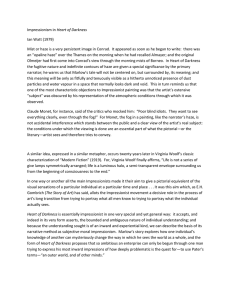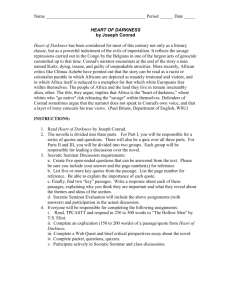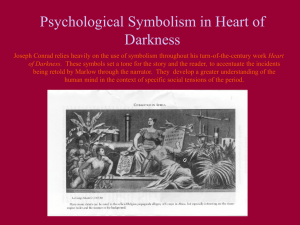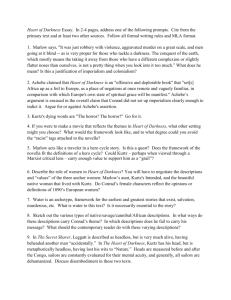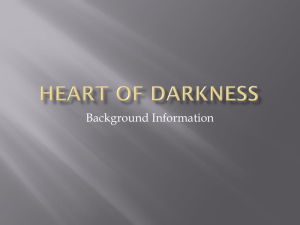Heart of Darkness - APE LIT Survival Guide
advertisement
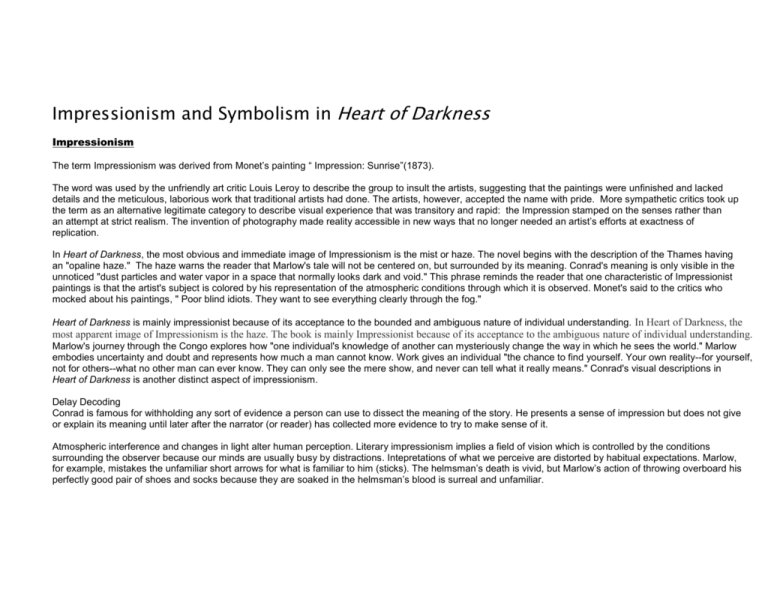
Impressionism and Symbolism in Heart of Darkness Impressionism The term Impressionism was derived from Monet’s painting “ Impression: Sunrise”(1873). The word was used by the unfriendly art critic Louis Leroy to describe the group to insult the artists, suggesting that the paintings were unfinished and lacked details and the meticulous, laborious work that traditional artists had done. The artists, however, accepted the name with pride. More sympathetic critics took up the term as an alternative legitimate category to describe visual experience that was transitory and rapid: the Impression stamped on the senses rather than an attempt at strict realism. The invention of photography made reality accessible in new ways that no longer needed an artist’s efforts at exactness of replication. In Heart of Darkness, the most obvious and immediate image of Impressionism is the mist or haze. The novel begins with the description of the Thames having an "opaline haze." The haze warns the reader that Marlow's tale will not be centered on, but surrounded by its meaning. Conrad's meaning is only visible in the unnoticed "dust particles and water vapor in a space that normally looks dark and void." This phrase reminds the reader that one characteristic of Impressionist paintings is that the artist's subject is colored by his representation of the atmospheric conditions through which it is observed. Monet's said to the critics who mocked about his paintings, " Poor blind idiots. They want to see everything clearly through the fog." Heart of Darkness is mainly impressionist because of its acceptance to the bounded and ambiguous nature of individual understanding. In Heart of Darkness, the most apparent image of Impressionism is the haze. The book is mainly Impressionist because of its acceptance to the ambiguous nature of individual understanding. Marlow's journey through the Congo explores how "one individual's knowledge of another can mysteriously change the way in which he sees the world." Marlow embodies uncertainty and doubt and represents how much a man cannot know. Work gives an individual "the chance to find yourself. Your own reality--for yourself, not for others--what no other man can ever know. They can only see the mere show, and never can tell what it really means." Conrad's visual descriptions in Heart of Darkness is another distinct aspect of impressionism. Delay Decoding Conrad is famous for withholding any sort of evidence a person can use to dissect the meaning of the story. He presents a sense of impression but does not give or explain its meaning until later after the narrator (or reader) has collected more evidence to try to make sense of it. Atmospheric interference and changes in light alter human perception. Literary impressionism implies a field of vision which is controlled by the conditions surrounding the observer because our minds are usually busy by distractions. Intepretations of what we perceive are distorted by habitual expectations. Marlow, for example, mistakes the unfamiliar short arrows for what is familiar to him (sticks). The helmsman’s death is vivid, but Marlow’s action of throwing overboard his perfectly good pair of shoes and socks because they are soaked in the helmsman’s blood is surreal and unfamiliar. Symbolism Before Romanticism, symbolism was not common. Things were what they were with no deeper meanings to inanimate objects. Symbolism involves giving a particular object or event some larger, non-literal meaning that reinforces or connects to a theme. 1. Allusion 2. o o o o o Marlow's journey can be seen as his descent into hell. (Dante's Inferno allusions) the two knitting women are "guarding the door of Darkness." the two youths are "being piloted over" company station in Brussels = Limbo central station = the abode of fraudulent (Central Station Manager) and of hoarder (Brickmaker) Kurtz = "traitor of kindred and country” = Lucifer Even though there is a strong parallel structure between the two stories, Heart of Darkness’s allusions to the Inferno exist primarily to reinforce the novel’s imagery of hell, specific sins committed by the Europeans in Africa, and Marlow’s journey to the geographic and symbolic heart of darkness where he finds the ninth circle and chief sinner, Lucifer. The use of the Inferno allusions leaves no doubt about Conrad’s condemnation of Kurtz’s actions. The allusions are symbolic of the hell created by the Europeans in Africa and the sins committed to do so. 2. Light-Dark imagery Marlow's European conception of blackness as inferior or evil is undermined when he finds no moral darkness in the black inhabitants of Africa, but instead links many of the traditional negative connotations of darkness with the color white. For instance the white invaders portray blindness, selfishness, and cruelty; The reference to the city of sepulchral buildings and darkness on the inside The black natives being white on the inside. The Intended is pale in comparison to her all black attire. Marlow finds that light is no longer able to combat darkness Light is degraded to cold and an artificial brightness. Literary Impressionism Key Concept Heart of Darkness Authors are sometimes grouped together with other artists who share a similar vision or idea concerning how to approach their craft. The impressionist writers make up one of these groups. The most famous impressionists are perhaps painters, such as van Gogh and Renoir, whose works you’ve no doubt seen on posters and even coffee cups. Painters, however, aren’t the only artists whose work is impressionistic. There are several authors who also can be placed in this “school,” including Joseph Conrad, James Joyce, and Henry James. In literature, impressionist writers exhibit some or all of these characteristics: They use a narrative style that is intentionally ambiguous, placing more responsibility on the reader to form his or her own conclusions about events within the novel, rather than relying on the narrator. Conrad, for example, withheld details from the reader (a process known as delayed coding) so that the reader’s comprehension would be delayed as it initially for the narrator. Reality rests on quicksand, not concrete. Perceptions can be misleading. They often describe the action through the eyes of the character while the events are occurring, rather than providing details after the character has already processed the action. The result is sometimes like being in an accident – where everything appears to be moving in slow motion. All of the details seem unclear. They’re concerned with the “emotional landscape” of the setting. They’re interested in the ways the setting evokes certain emotional responses from both the characters and the reader because perception, imagination, comprehension, and even logic vary with context, making the “truth” difficult to determine. As in impressionistic paintings, the truth of what an individual sees or thinks she sees depends on the light in which it is seen. Monet painted his garden at different times of the days, presenting water lilies that changed color depending on shadows and sunshine. They employ details in such a way that it’s sometimes difficult to see a clear picture of events if you focus on the details too closely. Much like an impressionistic painting, it’s only possible to get a full picture once you stand back from the novel and view it in its entirety. The overall picture is closer to reality than any one particular detail. They often avoid a chronological telling of events. Instead, they give the reader information in a way that forces them to focus on how and why things happen, rather than on the order in which they occur. The following passage from Joseph Conrad’s Heart of Darkness reflects the impressionist style of writing: “I saw a face amongst the leaves on the level with my own, looking at me very fierce and steady; and then suddenly, as though a veil had been removed from my eyes, I made out, deep in the tangled gloom, naked breasts, arms, legs, glaring eyes – the bush was swarming with human limbs in movement, glistening, of bronze colour. The twigs shook, swayed, and rustled, the arrows flew out of them, and then the shutter came to.” Notice how Conrad’s narrator reports things as they’re happening, before he’s had a chance to process the information. Notice also the attention to color and movement. It’s interesting to note that at this point, the speaker is actually under attack. Yet it takes him a few more lines before he realizes this, further enhancing the sense that the reader is experiencing the attack with the narrator. It’s important to note here that authors don’t subscribe to a particular school and then write according to a set of rules or standards. It’s generally critics who come along later and notice trends between various artists who then place the artists in the various categories. To get a better idea of what an impressionist painting looks like, visit the Metropolitan Museum of Art’s Web site at http://www.metmuseum.org. Reading Heart of Darkness Once you've read Heart of Darkness, please complete the following writing activities as a way to help focus your attention on some of the key details. 1. 2. Please keep track of where Marlow travels, once he begins telling the story of his trip. Do this by noting the page number any place he mentions moving from one specific point to another. Then discuss any specific information concerning the place he goes and how long it takes to get there. Find and discuss briefly four references to work in Heart of Darkness. 3. Find three examples of the futility of the European presence in Heart of Darkness and discuss them. Answering this question will be particularly important when you begin your analysis essay using the Marxist literary lens. 4. Find two passages that seem intentionally ambiguous and have the action described through the eyes of a character while the events are occurring. Write the page number for each, provide some context, and then discuss your response to each passage. 5. Pick two of the following images and/or ideas and find at least three references to each. List the page reference and then discuss how the idea seems to work in the context of the novel as a whole: “savages,” grass, rivets, jungle, river, huts, disease, progress, madness, civilization. 6. Discuss three instances where Conrad uses white or “whiteness” as a symbol, and three where he uses black or “blackness.” Does he use these symbols in a traditional sense? Discuss. 7. Discuss why Conrad would use the frame story structure (story within a story) for this novel. In what way does this structure contribute to the meaning of the work as a whole?
